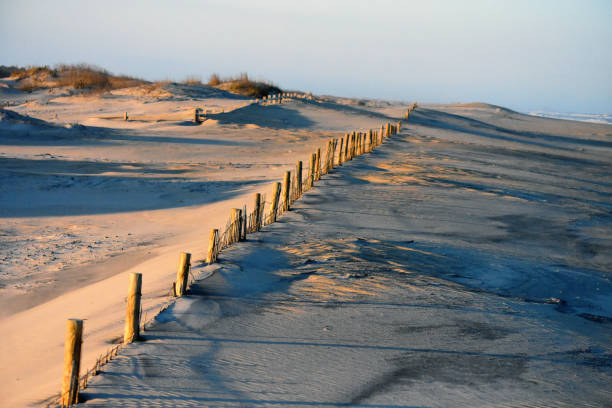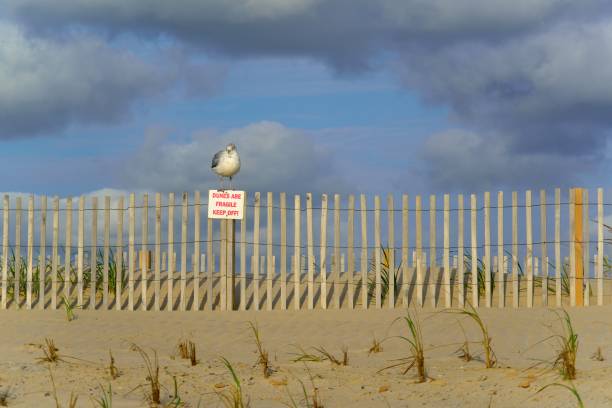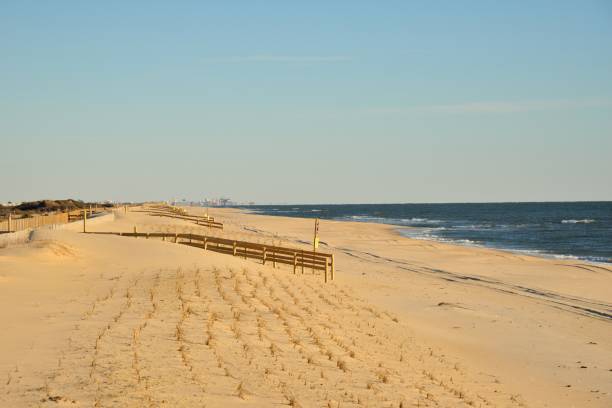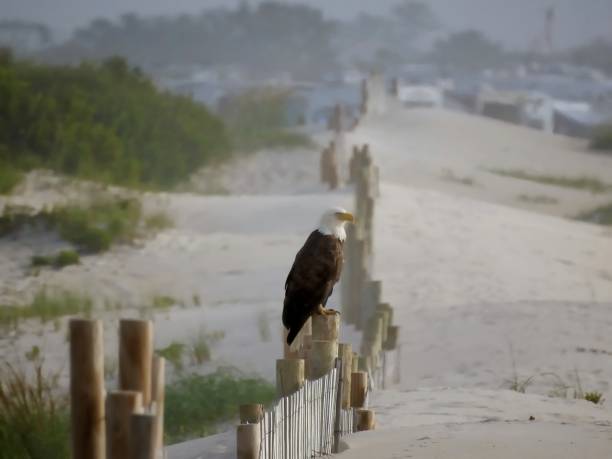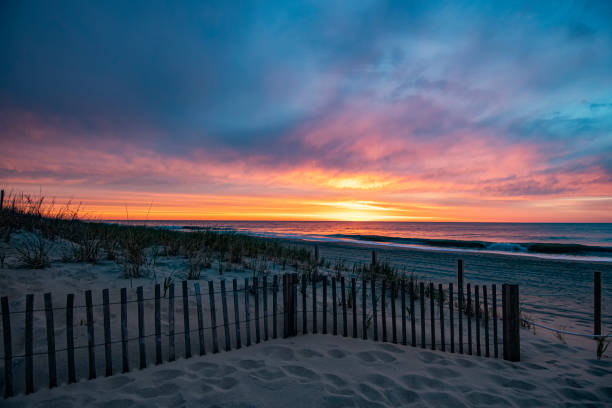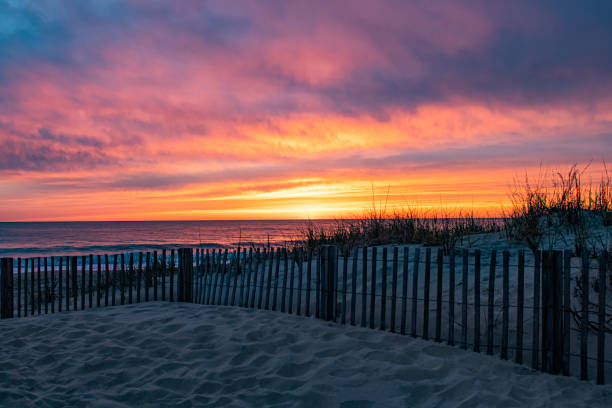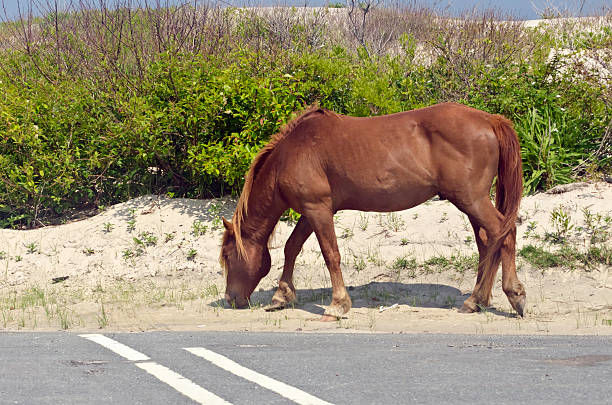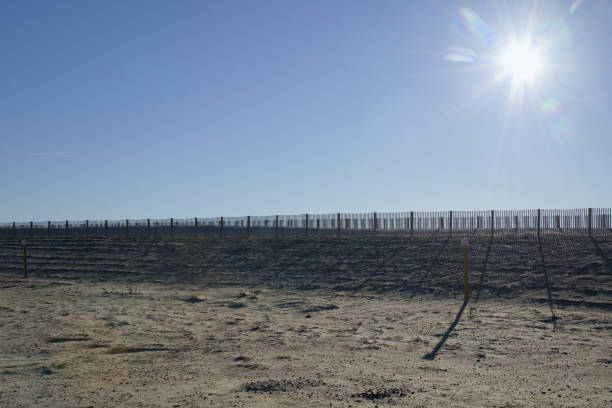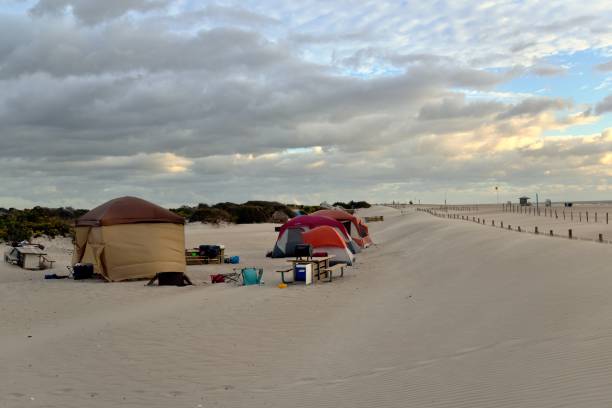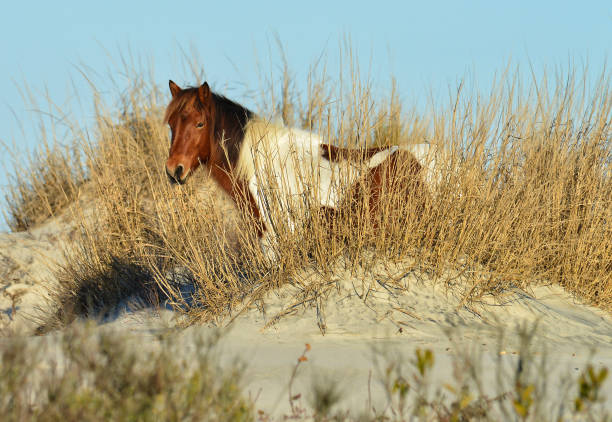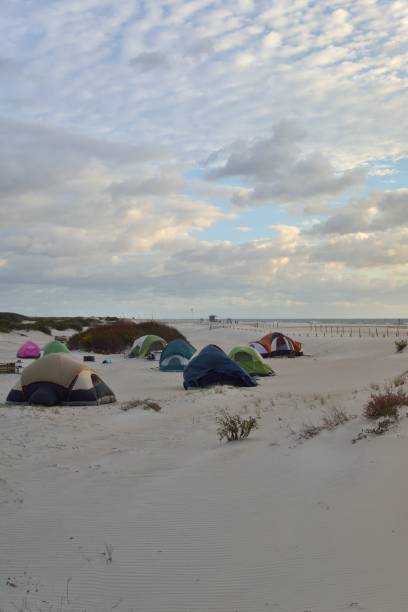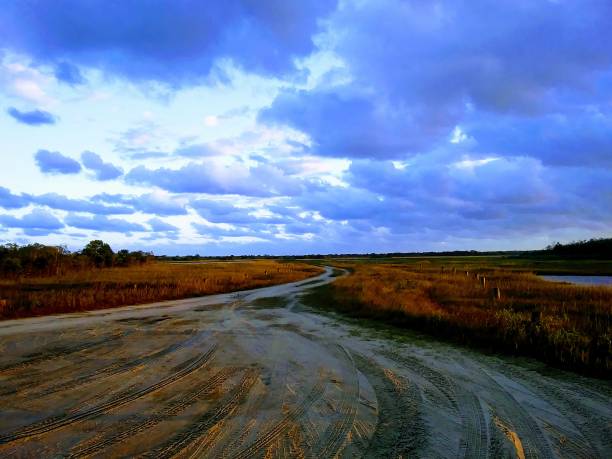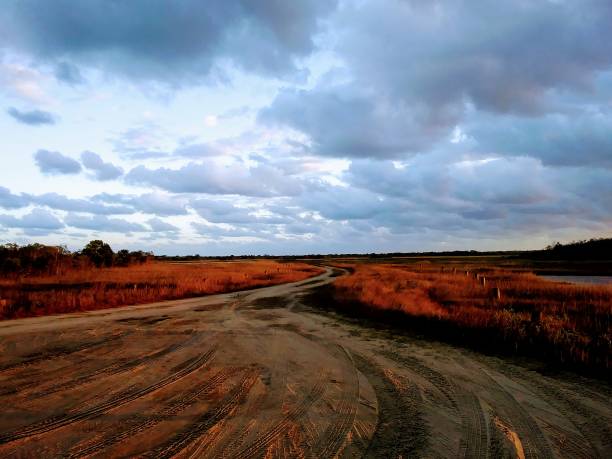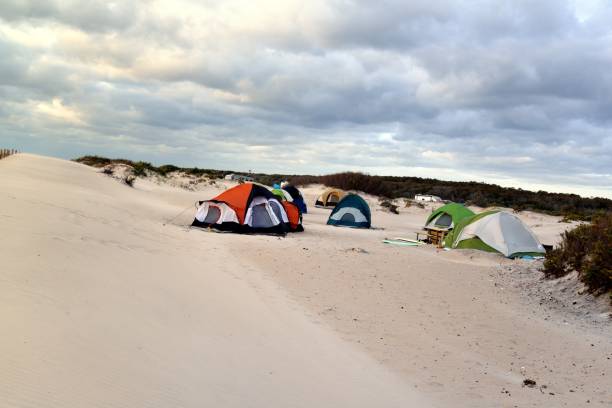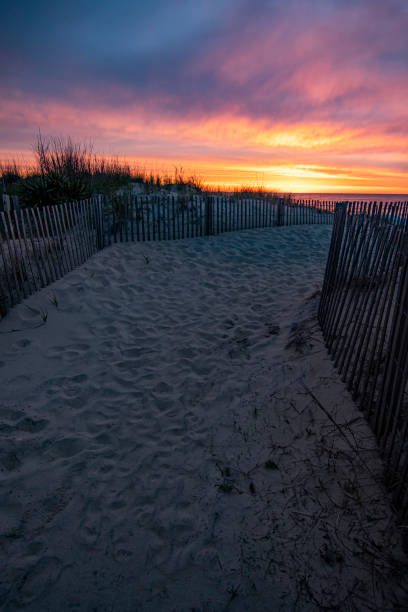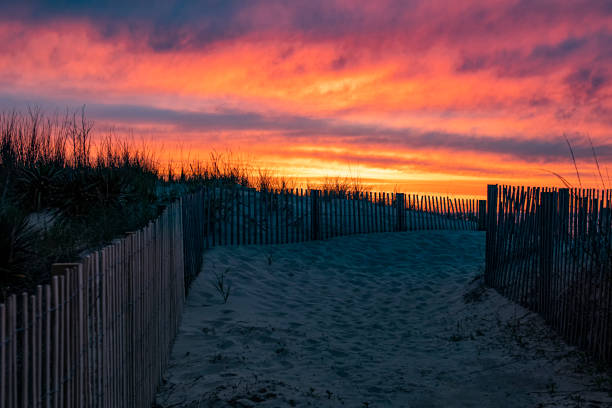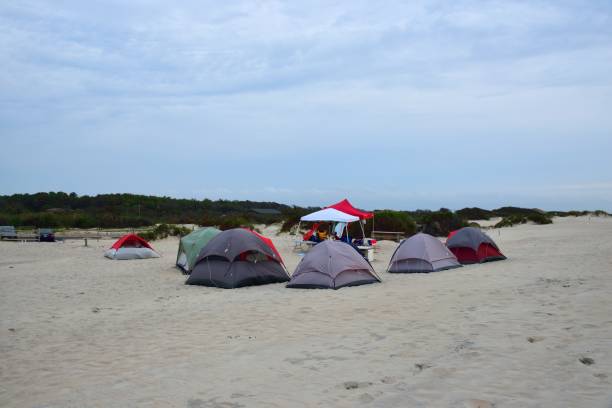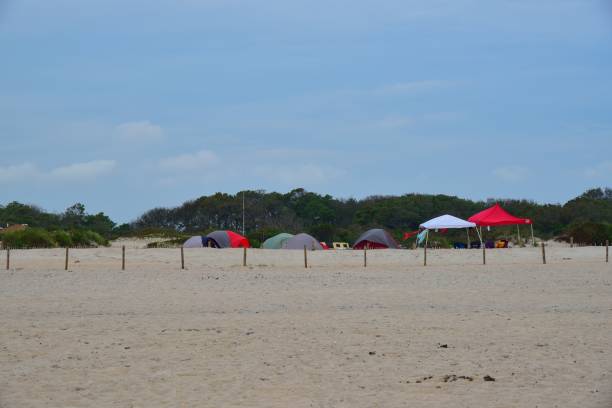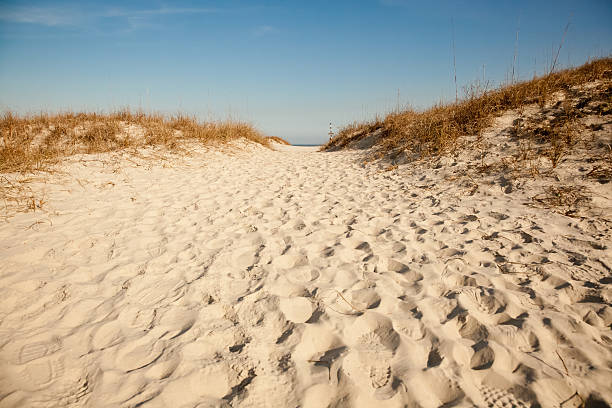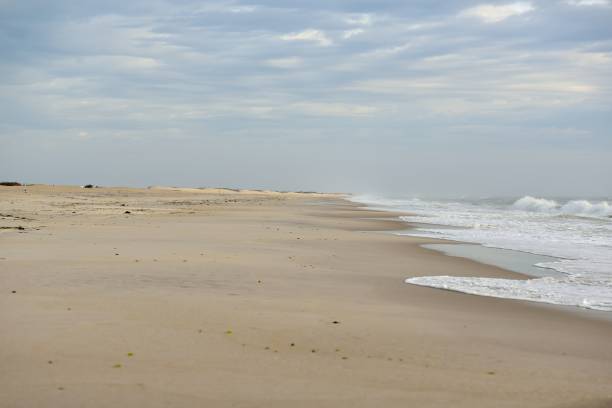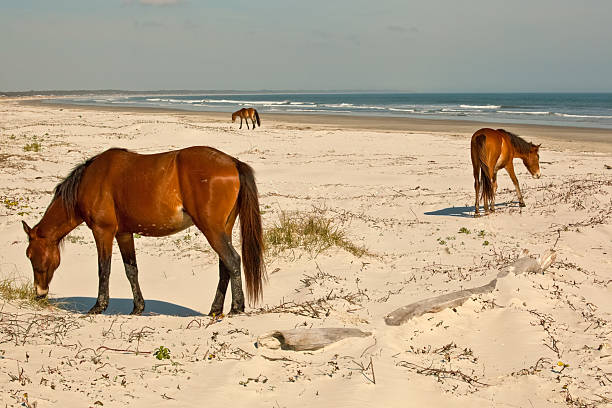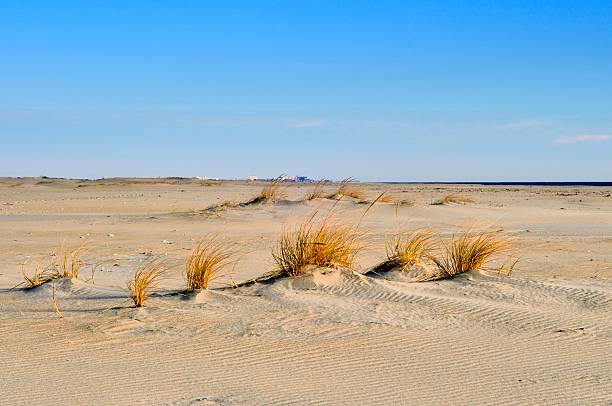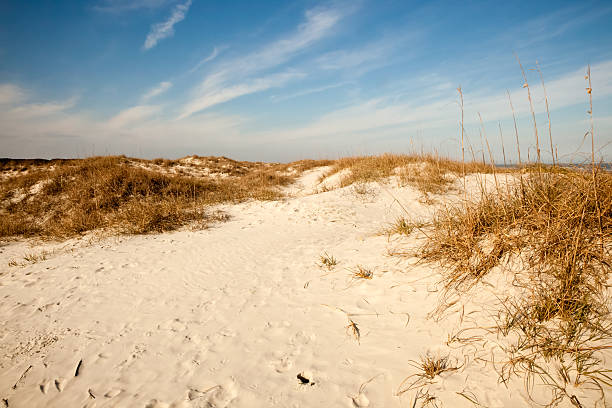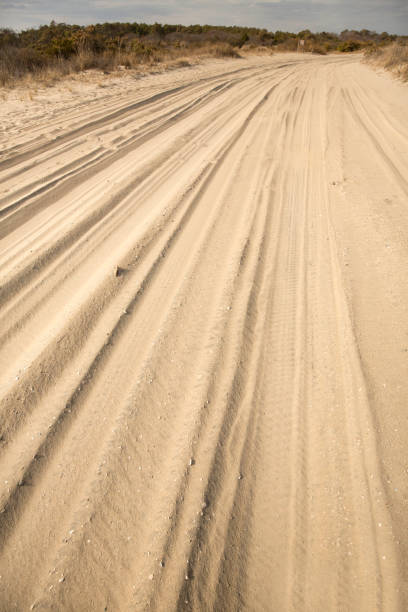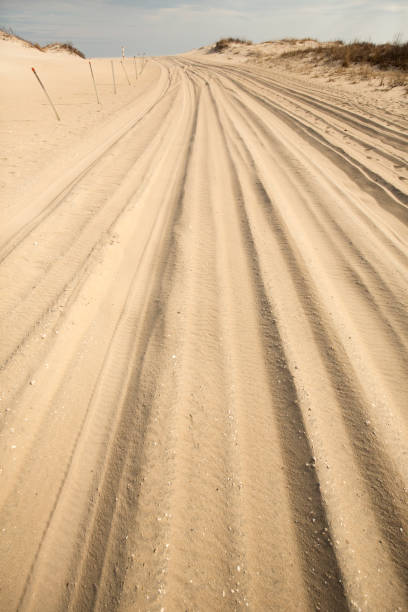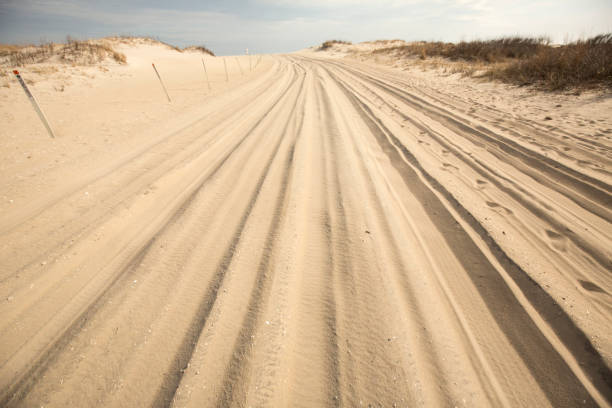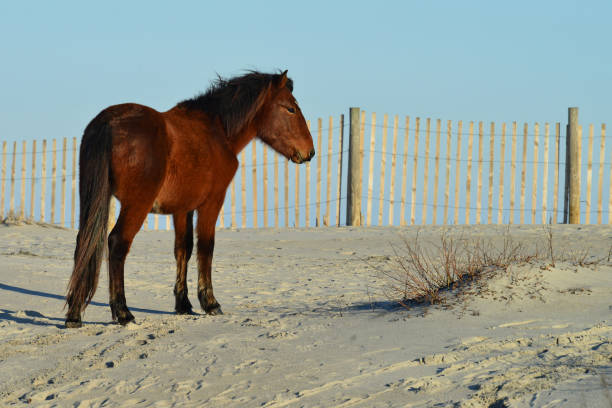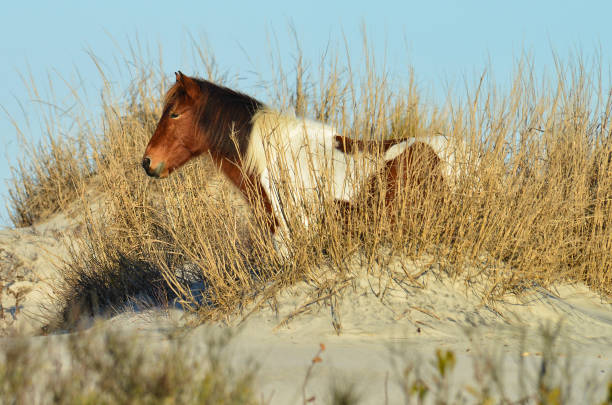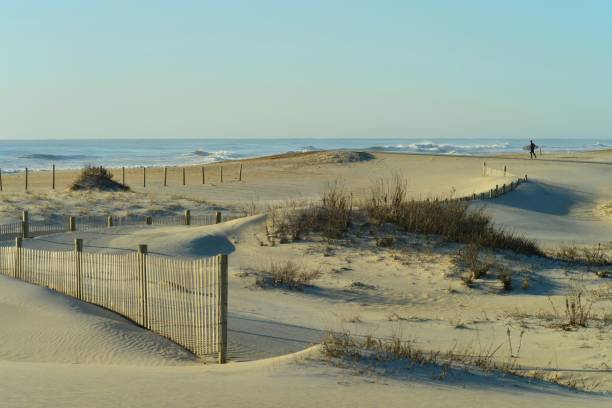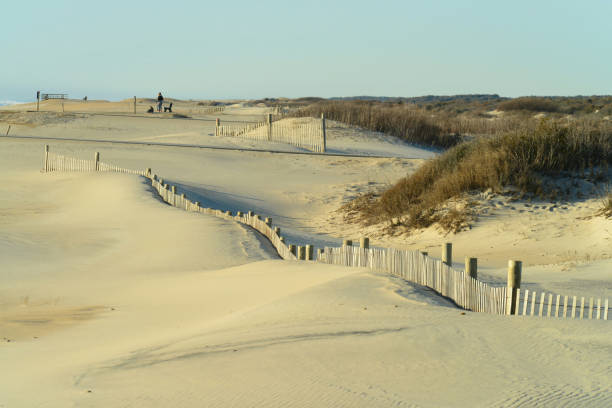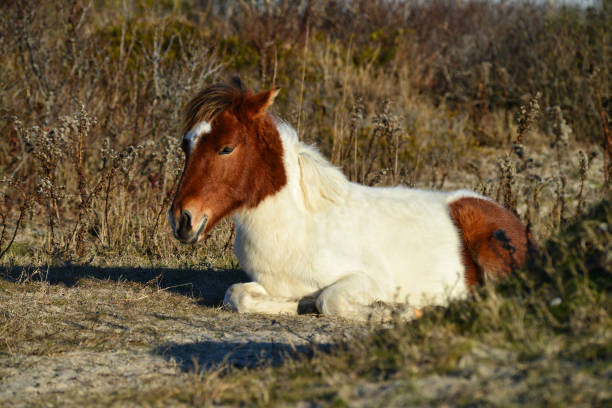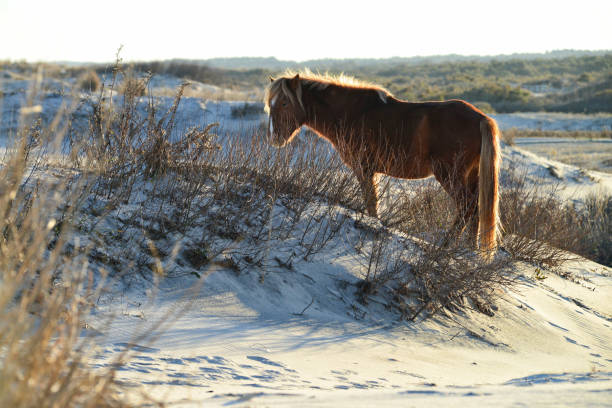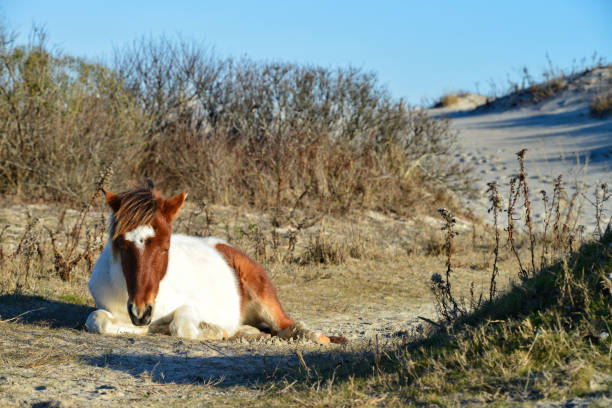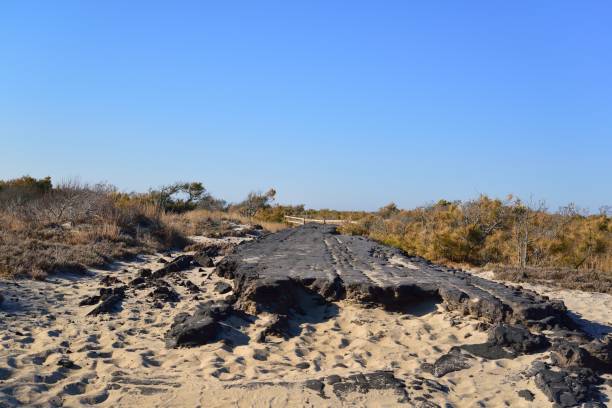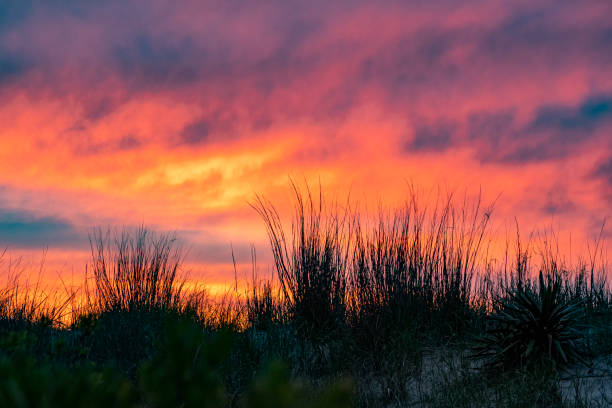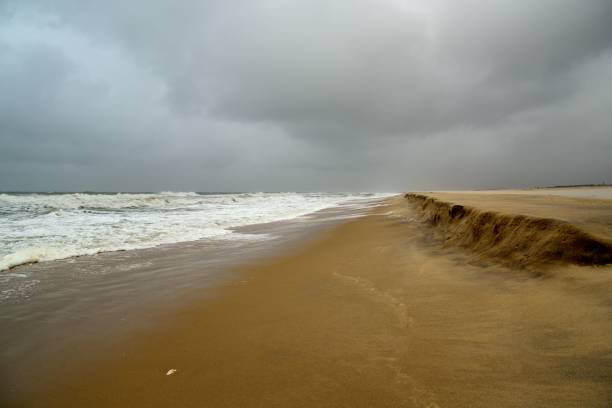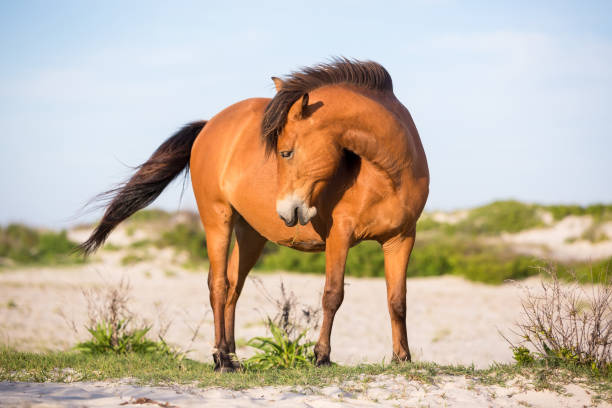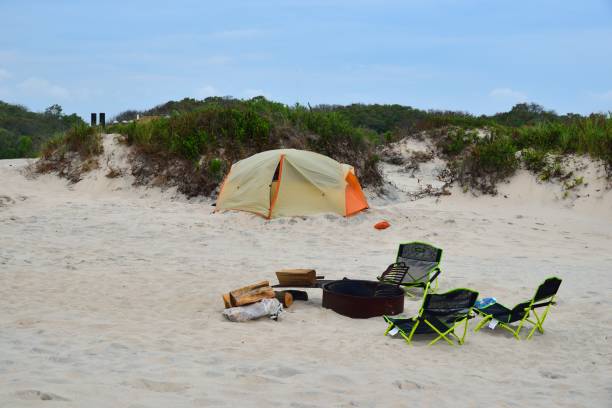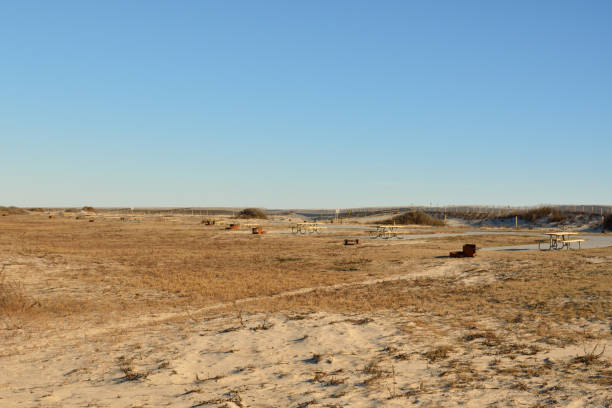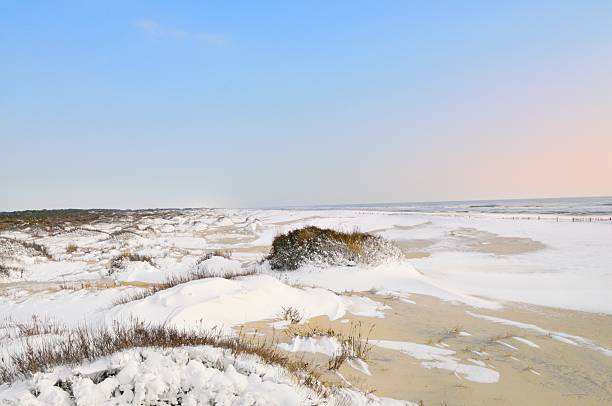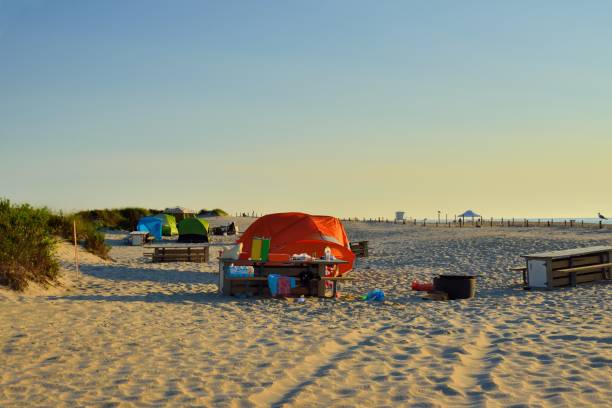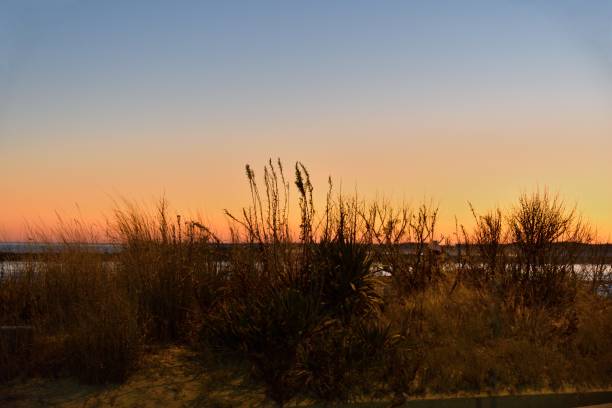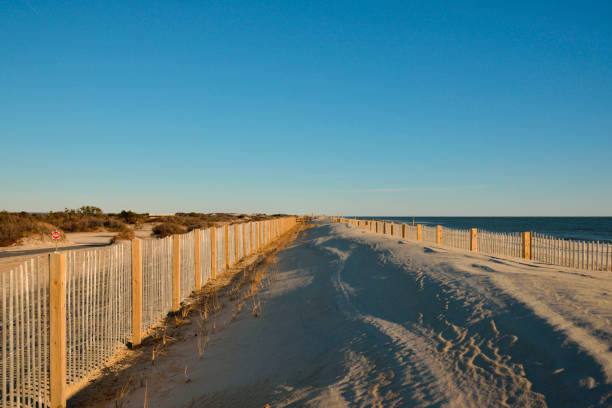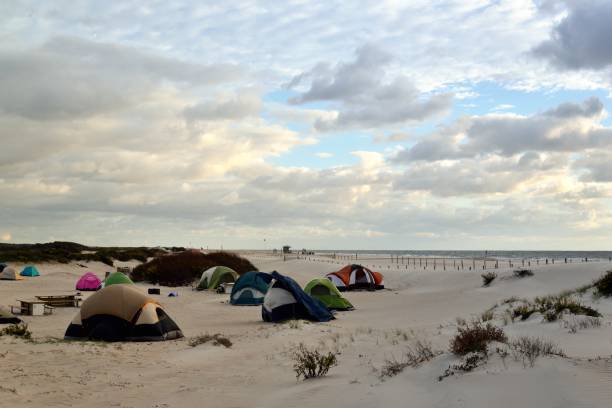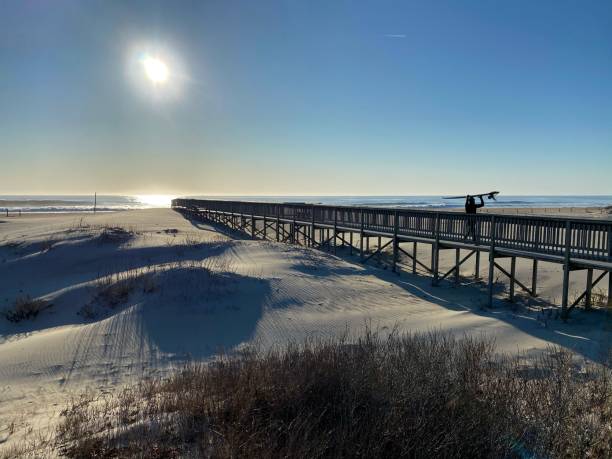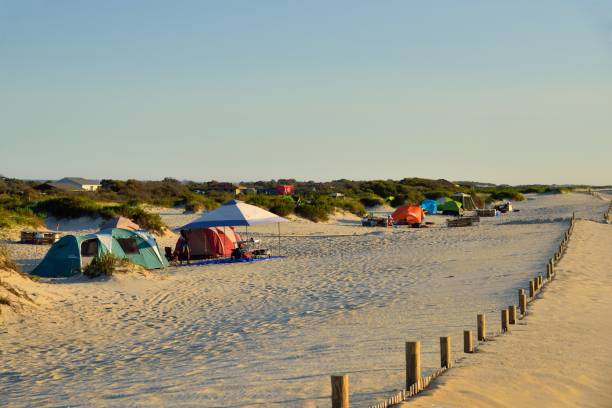
Eastern Shore Sand Sand Dune Beach Pictures, Images and Stock Photos
Browse 50+ eastern shore sand sand dune beach stock photos and images available, or start a new search to explore more stock photos and images.

A tent camping area in the sand dunes at the Assateague Island National Seashore on a cloudless August morning with the tourist still asleep in their tents
"The feral horses of Cumberland Island, Georgia are thought to be ancestors of horses either shipwrecked or abandoned there by Spanish explorers in the 1500's. Plantation owners who tried to make a living on the island also left horses behind. Over time the horses grew feral. Today there are around 150 wild horses living on the island. They live off of the wild sea oats and dune grasses that are found on the beaches. The two horses in this photo had been grazing on the beach and were starting to move into the dunes for longer grass. It is interesting to watch them stand on the beaches and enjoy the ocean breezes. Often they will lay down to rest in the wind. These wild horses are not afraid of people, in fact they act like they own the island. Park Rangers warn that if you come across them to yield the way because they won't! Cumberland Island's wild horses are a wonderful and amazing addition to the incredible beauty of this east coast barrier island."
A dune fence traverses the sand at Assateauge Island National Seashore.
A lone gull, guard gull, perching on a sign warning beach users to stay off the dunes in order to protect the newly plants grass intended to protect the dune from erosion brought on by climate change and sea level rise
A winter beach scene on the Maryland Assateague Island State Park with access walkways, dune restoration and the Ocean City skyline on the horizon 10 miles away,
A mature male bald eagle perching on a snow fence along the beach at Assateague Island National Seashore looking out to sea
A colorful sunrise over the beach access path between the sand dunes in Ocean City, Maryland
A colorful sunrise over the beach access path between the sand dunes in Ocean City, Maryland
Assateague Island National Seashore in eastern Maryland
A sand fence, or sand break if you wish, placed on top of dunes being restored after repeated flooding related to global climate change provides an interesting structure
Wild Assateague/Chincoteague pony stands on the sand dunes soaking up the afternoon sun at Assateague Island National Seashore in Maryland, USA
It’s October and the tourist still come to pitch their tents along the beaches of the assateague island national seashore and the families bring their children and pets to romp on the beach and collect seashells and other memories.
It’s October and the tourist still come to pitch their tents along the beaches of the assateague island national seashore and the families bring their children and pets to romp on the beach and collect seashells and other memories.
Beautiful wild horse/pony standing on the dunes and gazing at the camera at Assateague Island National Seashore in Maryland, USA
It’s October and the tourist still come to pitch their tents along the beaches of the assateague island national seashore and the families bring their children and pets to romp on the beach and collect seashells and other memories.
Dirt and sand road with blue cloudy sky and orangeish grasses
Dirt and sand road with blur cloudy sky and redish color grasses
It’s October and the tourist still come to pitch their tents along the beaches of the assateague island national seashore and the families bring their children and pets to romp on the beach and collect seashells and other memories.
A colorful sunrise over the beach access path between the sand dunes in Ocean City, Maryland
A colorful sunrise over the beach access path between the sand dunes in Ocean City, Maryland
A colorful array of tent domes peek over the sand dunes at the assateague island national seashore on a pretty clear summer morning
A colorful array of tent domes peek over the sand dunes at the assateague island national seashore on a pretty clear summer morning
"A beach is a landform along the shoreline of an ocean, sea, lake or river. It usually consists of loose particles which are often composed of rock, such as sand, gravel, shingle, pebbles or cobblestones. The particles comprising the beach are occasionally biological in origin, such as mollusk shells or coralline algae.Wild beaches are beaches which do not have lifeguards or trappings of modernity nearby, such as resorts, camps and hotels. They are sometimes called undeclared, undeveloped or undiscovered beaches. Wild beaches can be valued for their untouched beauty and preserved nature. Beaches typically occur in areas along the coast where wave or current action deposits and reworks sediments."
Winter beach on Assateague Island National Seashore with cumulus clouds and breaking surf.
Winter beach dunes on Assateague Island National Seashore with alto cumulus clouds shadowed dunes.
"The feral horses of Cumberland Island, Georgia are thought to be ancestors of horses either shipwrecked or abandoned there by Spanish explorers in the 1500's. Plantation owners who tried to make a living on the island also left horses behind. Over time the horses grew feral. Today there are around 150 wild horses living on the island. They live off of the wild sea oats and dune grasses that are found on the beaches. The two horses in this photo had been grazing on the beach and were starting to move into the dunes for longer grass. It is interesting to watch them stand on the beaches and enjoy the ocean breezes. Often they will lay down to rest in the wind. These wild horses are not afraid of people, in fact they act like they own the island. Park Rangers warn that if you come across them to yield the way because they won't! Cumberland Island's wild horses are a wonderful and amazing addition to the incredible beauty of this east coast barrier island."
"The feral horses of Cumberland Island, Georgia are thought to be ancestors of horses either shipwrecked or abandoned there by Spanish explorers in the 1500's. Plantation owners who tried to make a living on the island also left horses behind. Over time the horses grew feral. Today there are around 150 wild horses living on the island. They live off of the wild sea oats and dune grasses that are found on the beaches. The two horses in this photo had been grazing on the beach and were starting to move into the dunes for longer grass. It is interesting to watch them stand on the beaches and enjoy the ocean breezes. Often they will lay down to rest in the wind. These wild horses are not afraid of people, in fact they act like they own the island. Park Rangers warn that if you come across them to yield the way because they won't! Cumberland Island's wild horses are a wonderful and amazing addition to the incredible beauty of this east coast barrier island."
Ocean City Maryland from Assateague Island National Seashore, but it could be any city on any beach. It is winter and cold with nice light on the dune grass with the effects of wind lowing on the sand apparent.
"Cumberland Island is the largest and southernmost barrier island in Georgia. It was the private playground of Thomas Carnegie and his wife Lucy with some descendants still owning property on the island. In 1972, a large portion of Cumberland was turned over to the Federal Government by the Carnegie family and it was turned into a National Seashore. With little commercial development, Cumberlandaas eco-system has remained relatively stable over the last several hundred years.However, barrier Islands are dynamic environments. For visitors who spend a few hours or a few days on Cumberland this soon becomes apparent. Wind shapes the dunes, Fire shapes the plant and animal communities that depend on them, and humans leave their impact too.Cumberland Island supports a rich diversity of animals, plants and offers amazing views of the Atlantic Ocean and Cumberland Sound."
Trail for off-road vehicles in the sand on the beach of Assateague Island National Seashore in Berlin, Maryland, USA.
Trail for off-road vehicles in the sand on the beach of Assateague Island National Seashore in Berlin, Maryland, USA.
Trail for off-road vehicles in the sand on the beach of Assateague Island National Seashore in Berlin, Maryland, USA.
Majestic Stallion standing on a sand dune at Assateague Island National Seashore in Maryland, USA staring off toward the sun. Assateague has a large population of wild ponies. It has been suggested that the ponies are descendants of survivors of a shipwrecked Spanish galleon.
Beautiful wild pony at Assateague Island National Seashore in Maryland, USA standing on a sand dune gazing off into the distance. Assateague Island has a large population of wild ponies which it has been suggested are descendants of survivors of a shipwrecked Spanish galleon.
Tranquil winter landscape at Assateague National Seashore in Maryland, USA. One lone surfer runs to the beach for winter time thrills. Assateague has miles and miles of beach and sand dunes. Assateague is a popular destination for vacationers looking to go camping, off-roading, fishing, wildlife viewing, boating, water sports, surfing or just enjoying the quiet serenity and the herd of wild ponies that live on the island. Assateague is particularly peaceful in the off season.
Serene landscape at Assateague Island National Seashore in Maryland, USA. Assateague has miles and miles of beach and sand dunes. Assateague is a popular destination for vacationers looking to go camping, off-roading, fishing, wildlife viewing, boating, water sports, surfing or just enjoying the quiet serenity and the herd of wild ponies that live on the island. Assateague is particularly peaceful in the off season.
Young wild pony resting on the ground at Assateague Island National Seashore in Maryland, USA. Assateague has a large population of wild ponies. It has been suggested that the ponies are descendants of survivors of a shipwrecked Spanish galleon.
Beautiful wild pony is illuminated by the late day sun as it stands on a sand dune at Assateague Island National Seashore in Maryland, USA. Assateague has a large population of wild ponies. It has been suggested that the ponies are descendants of survivors from a shipwrecked Spanish galleon.
Young wild pony taking a nap in the late afternoon at Assateague Island National Seashore. Assateague has a large population of wild ponies. It has been suggested that the ponies are descendants of survivors from a shipwrecked Spanish galleon.
The remains of a road in the Assateague Island National Seashore destroyed by a storm in 1962. The road is slowly being remove from the park to allow nature to restore the area.
The feral horses of Cumberland Island, Georgia are thought to be ancestors of horses either shipwrecked or abandoned there by Spanish explorers in the 1500's. Plantation owners who tried to make a living on the island also left horses behind. Over time the horses grew feral. Today there are around 150 wild horses living on the island. They live off of the wild sea oats and dune grasses that are found on the beaches. The two horses in this photo had been grazing on the beach and were starting to move into the dunes for longer grass. It is interesting to watch them stand on the beaches and enjoy the ocean breezes. Often they will lay down to rest in the wind. These wild horses are not afraid of people, in fact they act like they own the island. Park Rangers warn that if you come across them to yield the way because they won't! Cumberland Island's wild horses are a wonderful and amazing addition to the incredible beauty of this east coast barrier island.
A colorful sunrise over the American beachgrass on the sand dune in Ocean City, Maryland
A persistent Nor’easter blowing onto assateague island national seashore is causing severe beach erosion and his seas flooding the dunes
This is the historic Indian River Lifestation over the sand dunes and on the beach are several ORVs with fishermen surf fishing in the Atlantic Ocean at dawn
A wild pony (Equus caballus) at Assateague Island National Seashore, Maryland
A dome tent in the background, and yes they are still asleep, with a fire pit and folding chairs for their night time gathering
A campground in Maryland’s Assateague State Park on a bright clear day in winter with the picnic tables and camping locations vacant for the season
The Assateague Island National Seashore beach in a wintry February scene with about 6 inches of snow in place early in the morning with the reddish glow of dawn still in the clear blue sky
An Assateague Island National Seashore tent camping on the sand dunes adjacent to the beach on a nice late August morning with foodstuffs and trash in evidence
The sea oats and sedges backlit by the setting sun over the ocean city maryland inlet on a cloudless winter evening
The Assateague Island National Seashore beach in a wintry February scene with about 6 inches of snow in place early in the morning with the reddish glow of dawn still in the clear blue sky
A double sand fence, or sand break if you wish, placed on top of dunes being restored after repeated flooding related to global climate change provides an interesting structure
It’s October and the tourist still come to pitch their tents along the beaches of the assateague island national seashore and the families bring their children and pets to romp on the beach and collect seashells and other memories.
Surfer walking down a boardwalk that connects to the beach at Assateaque Island in Maryland, USA. The morning sun is bright as it rises behind him casting him in silhouette.


